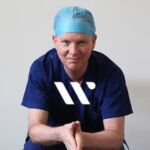
The idea of incisions makes some people squeamish, but it’s worth thinking about where they will be placed before you go into surgery. This is because the incisions will obviously determine the position of the scars that remain in the long term.
Modern surgical techniques allow us to place the incisions far more discreetly than used to be the case. If you choose a skilled surgeon, any scars that are visible should normally be hard to notice, as long as they heal well and you have a normal hairstyle.
The key incisions which have evolved are used for the simple reason that they are in the best-disguised location. In facelift surgery, they run around the border of the ears and into the hairline of the temple, to behind the sideburn and often into the hair, and along the hairline behind the ear, sometimes running down along the neck hairline. The incisions are placed here because they are the least visible that can be made on the face while still allowing significant change to the face. The idea is that they should be undetectable to others unless they look very closely.
Whenever there are incisions, there are always potential changes to the temple hairline and the earlobe. The reason that the incision runs into the temple hairline is because it elevates the skin of the lateral cheek and gives access to some of the cheek’s structures. When the cheek’s structures from the SMAS layer are brought back to tension in the mid-face, it can sometimes leave excess skin around the ears and some of this needs to be trimmed.
For a male or a female, this may mean moving the sideburn up or sometimes out – hopefully in a relatively minor way – reducing the amount of hair visible at the sideburn and sometimes increasing the height of the sideburn. If a person has very lax skin and I anticipate that we’ll need to remove a lot of skin from the upper lateral face, it’s usually better for the incision to go around the edge of the hairline and the sideburn and up into the temple – right at the junction of the hairline and the face. This avoids the need for the hairline to be moved back and is called the pretrichial approach.
I use this method because if there is a lot of excess skin produced during the lifting part of the procedure, it can be trimmed and inset as a fine, neat scar line at the junction of the hair and the face. No hairline is lost, i.e. the hairline is not moved back and since the incision is made at the junction of the hairline and the face, all the hair is preserved.
So, the whole thing becomes a trade-off. If there’s not a lot of skin to remove, it’s better to hide the scar from the ear going straight up into the temple hairline, so that it’s completely covered by the hair and there’s no visible scar around the sideburn or the temple hairline. However, if there’s a lot of skin to remove and the incision is made within the hair itself, dealing with the excess skin involves moving the hairline back a long way. This is not a good idea, as it makes the area look relatively bald and has an ageing effect. If this is the case, a fine scar at the border of the hairline is a better outcome because it preserves the hairline and creates a sense of youthfulness. It does place a scar at the border of the hairline on the face which can sometimes means the scar is visible unless the hair is kept over it. If the scar is poor-quality, it needs to be revised or touched up and if it heals very finely as it often does, the scar area can be exposed without being obvious.
The incision around the earlobe is important too. Many patients have what’s called a ‘free’ earlobe that hangs just over the bottom of the ear. However, some have an ‘attached’ earlobe which is attached to the side of the face. The facelift incision runs around where the earlobe attaches to the face, in front and behind.
If the earlobe is attached and the incision is stitched in that area, sometimes the skin retracts a little bit as the swelling goes down after the facelift. If this happens, it pulls the lobe forward into an unnatural position which is an obvious giveaway that there has been plastic surgery. So, the best strategy is to detach the earlobe a little, even if it was previously attached and to run the incision around the ear and under the earlobe so that it goes from the front of the ear to the back of the ear at that level. In this way, even if the scar migrates a little bit, it will still be covered by the earlobe and be very inconspicuous.
Most of my patients are fine with this, but occasionally they get quite fixated about the earlobe shape. If this happens, the lobe can be reattached a few months later as a secondary minor office procedure. The reason I do this as a secondary office procedure is because on the day of the facelift I want to be able to suture the skin in firmly and if it migrates a little bit I don’t want it to detract from the appearance of the face. Waiting a while allows the skin to settle into a solid position so I can see exactly what I’m dealing with. From a surgeon’s point of view, both earlobe shapes are fine, and I am always pleased when the patient agrees with me because a freer lobe means a less obvious scar.
I hope this post has helped you understand how incisions are made in a facelift. You’ll find a lot more information on facelifts in my You Tube clips.





